|
May 2022
Greetings local history friends,
Check out what is new and noteworthy this month in Special Collections.

The Star Tribune reported on July 11, 1980, that eight field workers were undertaking a massive project to photograph every building in Minneapolis—as many as 200,000 images. The project was co-sponsored by the City of Minneapolis and the Minnesota Historical Society (MNHS), with the work carried out by staff from the University of Minnesota’s Center for Urban and Regional Affairs (CURA). The images created by the project were to be used by the Minneapolis Heritage Preservation Commission (MHPC) to find its “architecturally and historically significant buildings.”
The photographs were taken using black and white film. Paperwork was signed to deposit the negatives with MNHS in 1984—but most of the negatives were apparently never actually transferred. All MNHS received was a single 3-ring binder containing about 2200 negatives. The binder was filed and forgotten, until recently.
Jennifer Huebscher, MNHS’s photographic curator, unearthed the binder last fall, found the corresponding paperwork, and began searching for the remaining negatives. After much research, she determined they were indeed never received. Since the single binder of negatives appeared to be such a small portion of the work of this project, she started looking for a more appropriate repository for them. She noticed that Hennepin County Library Special Collections maintained a collection of materials from MHPC from the same time frame and asked us if we would be interested in accepting the binder. We said yes.
Since receiving the collection, Special Collections staff have also attempted to discover the fate of the missing negatives by contacting the MHPC, City archives staff, and past employees of CURA (including our own volunteer, Will Craig, who worked for CURA when this project was taking place). We found people who could remember the project and knew people who worked on it, but no one knew what happened to the photographs or the negatives. It’s possible some of the photographs were used for a time then discarded and the negatives were simply never retained, beyond this one binder. It’s also possible they were forgotten in some filing cabinets somewhere in the many hiding places in City Hall. It remains a mystery.
In the meantime, Special Collections project worker Abbey Hemken has digitized all of the negatives and is creating the metadata for each image. They will eventually be added online to the Minneapolis Heritage Preservation Commission Collection.
-Ted Hathaway, Manager, HCL Special Collections, Preservation and Digitization
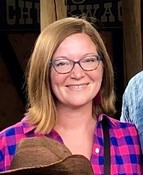 |
|
Sara began volunteering in Special Collections in 2018 and was hired as a part-time project worker about a year later. Initially she was a lead worker on the Star Tribune Photograph Collection processing project. She transitioned to doing metadata and preservation on the Minneapolis Newspaper Photograph Collection in 2021. Sara lives in Northeast Minneapolis with her family. |
Q: Why did you start volunteering in Special Collections?
A: Once my youngest started kindergarten, I wanted to ease my way back into the workforce. I have a degree in history and knew I wanted to be in a library, preferably behind the scenes working with older, local materials. I completely lucked out with placement in Special Collections!
Q: What’s your favorite part of the job?
A: I love cleaning heavily edited photos to reveal the original. Many newspaper photos were painted to hide shadows or to create more contrast, but often the paint covered bags under the eyes, a stray hair, a bad set of teeth.
My favorites are when entirely new outfits were painted on, usually a business suit or tie [like below], or a lowered hem when a woman's dress was deemed too short. I don't believe this one [on right] ever appeared in the paper, but I love the note on the back for the art department: “paint pants on her.” |
|
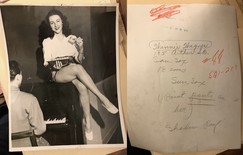 |

Q: If you lived in Minneapolis in the 1930s/40s, what do you think you would have been in the newspaper for, or what would you have liked to have been in the newspaper for?
A: I hope I would have been in the newspaper for something school related, like academic achievement or participation in a band or music competition. I definitely would not have been featured in the sports or society pages!
Q: Favorite book of all time?
A: I don't have a single favorite, but there are comforting books I go back to over and over, usually in the dead of winter when I'm in a funk. Like the Mary Russell series by Laurie R. King, Jane Austen novels, anything by David Sedaris to laugh out loud, and of course, Harry Potter.
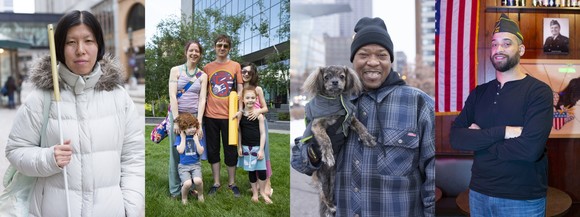
Recent acquisitions
Stephanie Glaros' Humans of Minneapolis records
Hundreds of digital photographs, plus audio recordings, videos, and more from Stephanie Glaros' Humans of Minneapolis project. In 2010, Glaros began talking with and photographing people she met on her daily walks in downtown Minneapolis. Inspired by Humans of New York, she founded Humans of Minneapolis, a nonprofit organization working to "bridge differences and encourage empathy through dialogue, storytelling, and community engagement." Glaros posted many of her photographs and brief interviews on her social media channels. She published a book, Humans of Minneapolis: Portraits and Interviews by Stephanie Glaros, in 2017. Glaros is a local Minneapolis artist, speaker, author and educator. Her work has been featured in many local publications and media outlets. Most photos include photographed person's first name, location, and brief descriptive information. The collection will eventually be made available in the Hennepin County Library Digital Collections.
Bob Lewis Campaign Materials
Newspaper clippings, correspondence, photographs, VHS tape, and buttons documenting Bob Lewis' campaign for state senate. B. Robert "Bob", "Bert" Lewis, Sr. was a Minnesota state senator representing St. Louis Park from 1973 to 1979. He was the first known African American to serve in the Minnesota Senate and a member of the Democratic-Farmer-Labor Party. Lewis was born November 2, 1931 in Hutchinson, Kansas. Before becoming a state senator, Dr. Lewis worked as a veterinarian and served on both the St. Louis Park School Board and the Minnesota State Board of Education. He died from a heart attack on April 25, 1979. Materials compiled by Lewis' campaign manager, Louis Schoen.
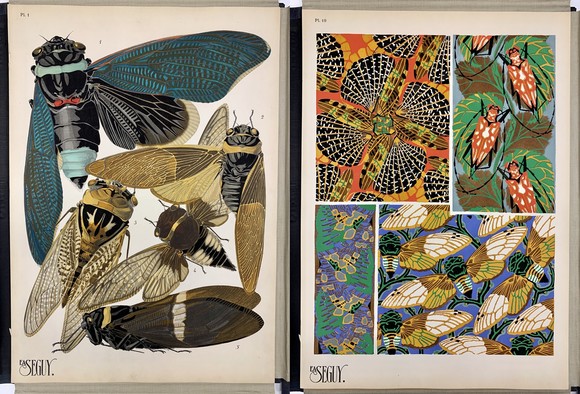
These gorgeous pochoir prints by French designer E.A. (Emile-Allain) Séguy were a showstopper at our recent Special Collections rare book tours. Learn more about Séguy and the labor-intensive printing process used to create these vivid designs on our blog. Discover more of Séguy’s work at our library.
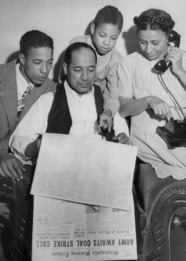 |
|
Special Collections is open Monday through Thursday 9am-4:30pm. Appointments are not necessary, but you do need to call Special Collections or check-in at the 4th floor reference desk upon arrival for department access. You can speed up your visit by requesting materials be pulled in advance. Masks are currently required regardless of vaccination status.
Don’t forget, even though Special Collections is now open, we can still help you with your research needs remotely. Need a scan of a book chapter from the Minneapolis History Collection? Looking for newspaper articles on a topic? Need a city directory look-up? We are here to help.
|
Phone photo: The Allen family, residents of Sumner Field Homes, seek new housing due to their family income exceeding limits allowed for residence in the Federal housing project. The post-war housing crisis made their search difficult. December, 1946.
Email specialcoll@hclib.org or call 612-543-8200.
|